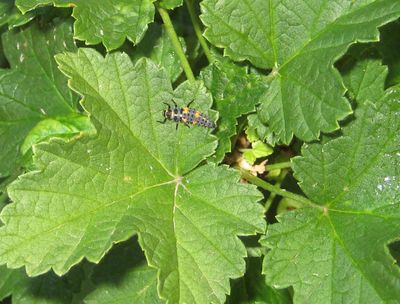Give garden insects a place to call home

If you think the insect world is out to get your plants, take comfort in the fact that we actually have a lot of insect allies out there. We just need to make them feel at home in our gardens.
To do this, set aside a border of your garden for plants that will provide nectar, pollen, foliage and shelter.
Members of the carrot family – such as parsley, dill, caraway and fennel – are an excellent choice. Members of the mint family – such as catnip, lemon balm and hyssop – are also a good attractant, but keep in mind that some can be invasive.
All of these plants are easily found at garden centers in the herb section.
Take the time to identify the insects in your garden so you know whether they’re the good guys or the bad guys. Sometimes a scary-looking bug is a gardener’s best friend.
Here’s a quick look at the most common beneficial insects in this region and what they like to eat. Use an insect guide or the Internet to see what they look like.
Aphid midge : The orange larvae of this fly will eat more than 60 different species of aphids. They are often found in roses and fruit trees and are frequently used in greenhouses for aphid control.
Big-eyed bugs: These bugs get their name from their large reddish-brown eyes. They eat aphids and the larvae of many harmful insects.
Braconid wasps: These small wasps won’t sting us but parasitize aphids by laying eggs inside them. A wasp larva eats the aphid’s insides and then spins a cocoon from which it later emerges as an adult. They also attack beetle larvae, codling moths and caterpillars.
Damsel bugs: These ½-inch-long insects kill aphids, leafhoppers, caterpillars and thrips.
Hover flies: These flies get their name by hovering above flowers. They look similar to bees and mainly attack aphids.
Ichneumon wasps: These cool-looking wasps, some of which have long, black ovipositors, won’t sting humans but are good at killing caterpillars and beetle larvae.
Lacewings: Another familiar insect, both the adults and larvae have big appetites for aphids, mealy bugs, thrips, mites and scale.
Lady beetles: Everybody is familiar with the adults but their larvae, which look like little brown and orange alligators, have voracious appetites. Both adults and larvae love to eat aphids, mealy bugs and spider mites.
Minute pirate bug: Anyone who deals with thrips will be happy to hear they are a mainstay of this insect’s diet. They also go after aphids and spider mites. At only 1/16-inch long, they develop from an egg into an adult in about 15 days.
Praying mantis: Another very familiar insect, we usually see them in late summer. They eat moths, flies, aphids, leafhoppers and mosquitoes. The adult females lay egg clusters encased in a brown shell that over-winter and then hatch in the spring.
Predacious ground beetles: Both the adults and larvae have large mandibles for catching prey like cutworms, slugs and maggots.
Spiders: Yes, they’re creepy, but they love to eat insects. The best thing we can do is leave them – as well as the webs they use to capture prey – alone.
Tachinid flies: These hairy flies lay eggs on the larvae of beetles, butterflies and moths. The fly larvae then parasitize the host.
You can purchase beneficial insects like praying mantises, lady beetles and lacewings to release in your garden. Just remember that they will go where the food is, irrespective of your property line.